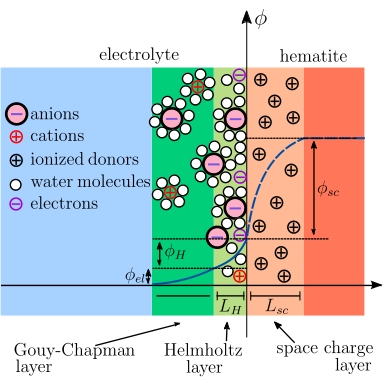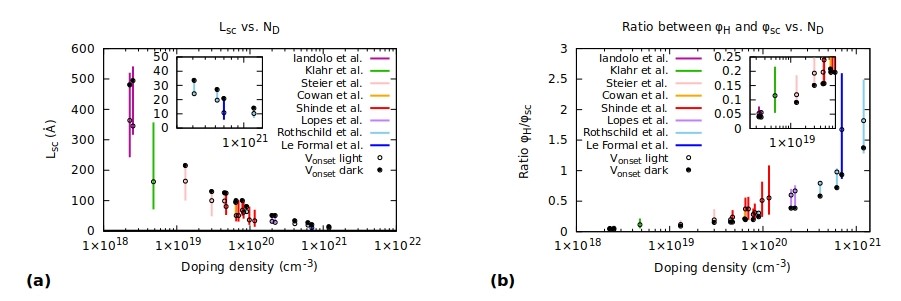PhD Top Stories
Paola Delcompare-Rodriguez
A theoretical study of ultrathin space charge layer in hematite photoelectrodes
Doctoral Programme in Physics
Climate change and the increased global energy consumption require a change from conventional fossil fuels to greener options. One of the possible pathways is the direct storage of solar energy into chemical bonds. This can be achieved through photoelectrochemical reactions in photoelectrochemical cells (PEC), which are constituted by a photoanode, a cathode, an electrolyte and an external circuit. In this context, the photoelectrochemical splitting of water into molecular oxygen and molecular hydrogen is one of the reactions investigated. Hematite (a-Fe2O3) is an oxide that has been considered during the last decades as a potential photoanode due to its advantageous properties. However, it displays some drawbacks: low conductivity in the bulk, high-electron hole recombination and slow kinetics of the oxygen evolution reaction. The two latter occur due to the sluggish transfer of holes at the hematite/electrolyte interface.
A better understanding of the semiconductor-electrolyte interface would be important to rationalize these problems. In the simplest picture, this interface consists of a space charge layer in the semiconductor; a compact Helmholtz layer and a diffuse Gouy-Chapman in the liquid, see Figure 1. Much effort has been devoted to understand the semiconductor-electrolyte interface: starting from analytical models, its experimental characterization, to quantum mechanical ab-initio simulations. The latter have been thought unfeasible due to the size of the semiconductor-electrolyte interface, which is believed to extend over tens of nanometers to micrometers. However, in recent water splitting experiments, space charge layers smaller than 10 Ň were measured in highly doped nanostroctured hematite photoanodes, which in principle are accessible to quantum mechanical ab-initio simulations.

Figure 1: Diagram of semiconductor-electrolyte interface.
The existence of ultrathin space charge layers under water splitting conditions, opposes to the common belief that broad space charge layers are essential in photoelectrochemistry, since charge separation and transport occurs here. High doping concentrations lead to ultrathin space charge layers, however this condition is rarely identified in experiments. We used a set of continuous equations to show that similar space charge layers are also present in other water splitting experiments. Figure 2 a), shows the calculated width of the space charge layer as a function of the doping density. In the experiment by Le Formal et. al, the width of the space charge layer can be as small as 1 nanometer. This nanostructured sample displayed remarkably high photocurrent densities compared to other samples with similar doping densities but different microstructures, i.e. space charge layers of comparable width. The difference in microstructure might account for the efficiencies observed in the nanostructured sample, where the space charge layer represents a substantial volume-fraction of the photoanode.
At high doping densities a substantial fraction of the potential drop is located in the Helmholtz layer. In figure 2 b), we reported the ratio of the potential drop in the Helmholtz layer and the potential drop in the space charge layer as a function of the doping density. This contrasts with the conventional behavior of the interface, where the potential drop in the space charge layer dominates. The substantial drop in the Helmholtz layer occurs at the same high doping regime where ultrathin space charge layers develop. This impacts directly on the applicability of the Mott-Schottky equation on the extraction of information from experiments. In our work, we proposed a correction to the Mott-Schottky relation in the high doping regime and showed its behavior in two different limits.

Figure 2: (a) Calculated space charge layer width as a function of the doping density for different experiments. (b) Ratio between the potential drop in the Helmholtz layer and the space charge layer as a function of the doping density.
Considering that anodes with ultrathin space charge layers have proved to display high efficiencies, the atomistic characterization of the space charge layer in highly doped slabs is crucial to understand phenomena in this limit. We explored the evolution of the space charge layer as we added elements of reality to the surface using density functional theory (DFT): first we started with the (0001) stoichiometric surface, we hydroxylated each surface, we added one additional charge per surface and we doped the slabs at high doping concentrations (~1021 cm-3). With these simulations, we gave the first steps to understand space charge layers at an atomistic level, which also brings us closer to the goal of achieving greener energy sources and save our planet.
Authors and affiliations
Paola Delcompare-Rodriguez1, Nicola Seriani22The Abdus Salam International Centre for Theoretical Physics, Strada Costiera 11, 34151 Trieste, Italy
Contact
Paola Delcompare-Rodriguez, email: delcompare@iom.cnr.itReference
Paola A. Delcompare-Rodriguez, Nicola SerianiUltrathin space charge layer in hematite photoeletrodes: a theoretical investigation
Journal of Chemical Physics155, 114701 (2021)
DOI: 10.1063/5.0060417
Informazioni aggiornate al: 02.3.2022 alle ore 12:25
Contact: Webmaster - Università di Trieste pagina curata da: Research Doctorate

Piazzale Europa, 1 - 34127 - Trieste, Italia -
Tel. +39 040 558 7111 - P.IVA 00211830328
C.F. 80013890324 - P.E.C. ateneo@pec.units.it


